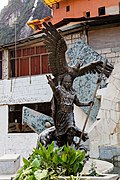Aguas Calientes, Peru
Machupicchu
Machu Pikchu Machupicchu Pueblo | |
|---|---|
Town | |
 Statue of Pachacutec | |
| Coordinates: 13°9′17.4″S 72°31′31.2″W / 13.154833°S 72.525333°W | |
| Country | Peru |
| Region | Cusco |
| Province | Urubamba |
| District | Machupicchu |
| Settled | 1901 |
| District Capital | 1 October 1941 |
| Government | |
| • Mayor | Edgar D. Miranda Quiñones |
| Elevation | 2,040 m (6,690 ft) |
| Population | |
| • Total | 1,600 |
| Time zone | UTC-5 (PET) |
Machupicchu (official name,[1] from Quechua Machu Pikchu machu old, old person, pikchu pyramid; mountain; or prominence with a broad base that ends in sharp peaks,[2] "old peak") or Machupicchu Pueblo (Spanish pueblo village), also known as Aguas Calientes[3] (Spanish agua water, caliente hot, warm, "hot waters" or "hot springs"), is a location in Peru situated in the Cusco Region, Urubamba Province.[4] It is the seat of the Machupicchu District. Machupicchu lies at the Willkanuta River. It is the closest access point to the historical site of Machu Picchu which is 6 kilometres (3.7 mi) away or about a 1.5 hours walk. There are many hotels and restaurants for tourists, as well as natural hot baths which gave the town its colloquial Spanish name. The baths were destroyed by floods several years ago, but have been rebuilt.
History
Settled by a few farm families in 1901, the tiny settlement was transformed into a busy railway worker's camp called Makinachayuq (Quechua makina (a borrowing from Spanish máquina) machine / locomotive, train,[5] -cha, -yuq suffixes, "the one with a little machine, locomotive or train", also Maquinachayoq)[6] during the construction of the railroad through there in the late 1920s. The town was the central hub for worker lodging and their equipment until the railway was completed in 1931.[7]
Transport
Machupicchu serves as a terminal for the PeruRail and Inca Rail passenger train service from Cusco. Trains serve locals and tourists arriving from Cusco and Ollantaytambo to visit Machu Picchu. A sheltered souvenir market is adjacent to the train station. Avenue Pachacutec is the main and only thoroughfare of the town, connecting the baths to the town's main square.
Industry
The Central Machupicchu Hydroelectric Plant (Hidroelectrica) is nearby at the Urubamba River. It generates about 90 MW for the regions of Cusco, Puno, and Apurímac . It was first constructed between 1958 and 1965 and expanded between 1981 and 1985. The plant was damaged by a landslide on 28 February 1998 and ceased operations until 13 July 2001.[8]
Gallery
-
Willkanuta River
-
Train tracks bisect the town
-
Machupicchu Village Scene, March 2006
-
Statue of Inka
-
Church Machu Picchu
Twin towns
See also
References
- ^ spij.minjus.gob.pe Ley 9396 (Law 9396 1 October 1941) (in Spanish): "... El nuevo distrito que se crea por la presente ley se denominará Machupicchu y tendrá por capital la población de este nombre que se ha formado alrededor de la actual Estación de Machupicchu. ..."
- ^ Teofilo Laime Acopa, Diccionario Bilingüe, Iskay simipi yuyay k'ancha, Quechua – Castellano, Castellano – Quechua (Quechua-Spanish dictionary): machu - adj. y s. m. Viejo. Hombre de mucha edad (Úsase también para animales). - machu - s. m. Anciano. Viejo. pikchu - s. Pirámide. Sólido puntiagudo de varias caras. machu pikchu - s. La gran ciudadela pétrea que fue quizá uno de los más grandes monumentos religiosos del incanato, entre el valle del Cusco y la selva virgen (JAL). || Monumento arqueológico situado en el departamento actual del Cusco, junto al río Urubamba, en una cumbre casi inaccesible (JL).
- ^ Municipalidad distrital de Machupicchu, Plan de desarrollo concertado del Distrito de Machupicchu 2011 - 2020 (in Spanish), p. 12: "... Machupicchu Pueblo mal llamado Aguas Calientes ..." (meaning "... Machupicchu Village, misnamed Aguas Calientes ...")
- ^ escale.minedu.gob.pe - UGEL map of the Urubamba Province (Cusco Region)
- ^ babylon.com
- ^ whc.unesco.org/download.cfm?id_document=100776 Report on the reactive monitoring mission to the historic sanctuary of Machu Picchu (Peru), 22 April to 30 April 2007
- ^ "Aguas Calientes History".
- ^ Template:Es icon Central Hidroeléctrica Machupicchu Empresa de Generación Eléctrica Machupicchu S.A.
External links
- Aguas-Calientes.com
- Aguas Calientes at cusco-peru.org
 Aguas Calientes travel guide from Wikivoyage
Aguas Calientes travel guide from Wikivoyage






